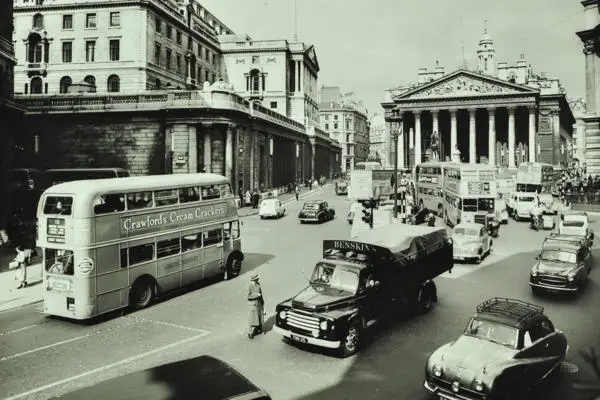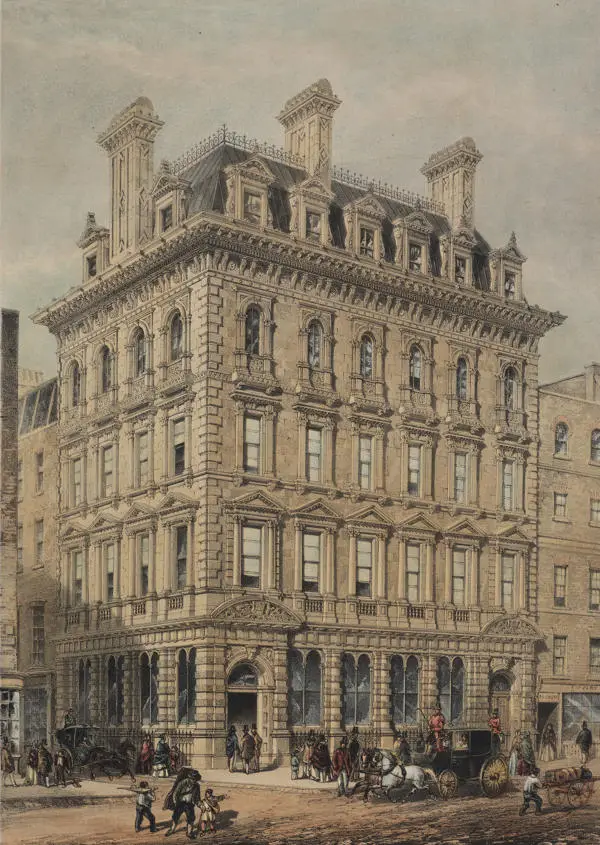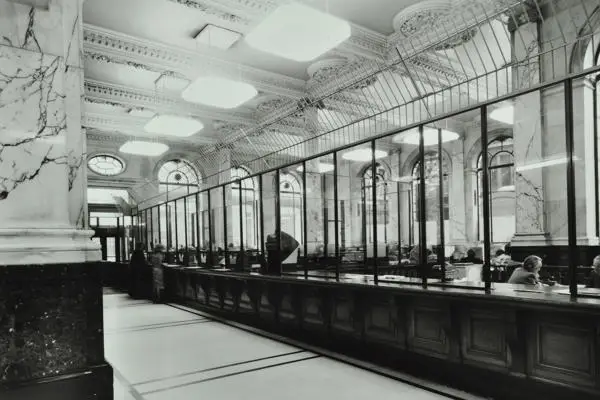Banks and bankers records
Records of some financial organisations held at London Metropolitan Archives
London Metropolitan Archives holds the largest single collection of business archives held by a local authority in England and Wales representing businesses mainly based in the 'Square Mile' of the City of London as well as in the wider Greater London region. LMA’s holdings are especially strong in merchant banking and insurance, particularly in the period before the Big Bang, and in this accruing series, compiled by Claire Titley, we take a closer look at the records of business organisations which represented the interests of City professionals and firms or regulated them, such as the Institute of Chartered Accountants (ICAEW), the British Bankers Association (BBA), the Association of British Insurers (ABI), the London Stock Exchange (LSE) and the London Chamber of Commerce (the other LCC).
These records are relatively underused, and can be a valuable source of information on a wide variety of topics including the development of financial products and services, resourcing (finance/staffing/investment), the effects of technological changes (development of the office, new processes, new markets), employment (demographics, culture, commuting), the development of finance-related professions and the relationship between them, investment at home and abroad, the development of global markets and of financial services in other territories, the study of commodities, the relationship between the City of London with government, political parties and public opinion, and the relationship between organisations (including the role of the Bank of England), and finally, but not exhaustively, the changes to the physical nature of the Square Mile itself, its margins and the growth of areas such as Canary Wharf.

At LMA you can find books on the City around shelf mark 33.0 in the LMA Library. David Kynaston’s 'City of London – The History' is particularly helpful; it is rich on colourful examples and his interest in social history makes it a fascinating read. (It is an abridged version of his 4 volume history, which LMA does not have). More analytical is Ranald Michie’s 'The City of London – Continuity and Change 1850-1990'. There is a useful little series of books with titles such as 'What goes on in the City?' by Nicholas Ritchie (33.0 RIT). These were published every so often with updated definitions and are useful for basic descriptions (for example, a 1970s one will give you a very clear picture of the City at that period). LMA is better stocked with histories of individual banks, around the same shelf mark.
Of course, Guildhall Library has a rich collection of printed sources related to business history, and researchers intending to do any proper background reading should start there.
We continue by looking at records to do with banks and bankers. And if you can’t tell a joint stock bank from a private bank, or a merchant bank from a clearing bank, and are puzzled about the functions of accepting and discount houses, we’ve come up with a handy glossary to help you.
British Bankers' Association
The British Bankers' Association was established in 1919 as a result of the merger of the Central Association of Bankers and the Association of English Country Bankers (for which LMA also holds records as part of this fonds). Its object was to better promote the interests of the banking community by having just one responsible association.
The Central Association had been established in 1895 by representatives of the London Clearing House, the West End banks and the Association of English Country Bankers to "safeguard the interests of bankers as a whole...without in any way interfering with the work of the older societies". From the start, the Central Association was a channel for consultation, information and defence of banks. It was not concerned with the interests of bank officials which were cared for by the Institute of Bankers, although it shared the Institute's premises at 34 St Clements Lane. The Association of English Country Bankers had been formed in 1874 to defend the interests of country banks.
Until 1972, membership of the British Bankers' Association was open only to British (including Dominion and Colonial) banks. After 1972, it was enlarged to include representatives of all recognised banks operating in the United Kingdom. In 1991, the Committee of London and Scottish Bankers, formerly the Committee of London Clearing Bankers, was subsumed into the Association.
Find out more on the LMA collections catalogue under reference CLC/B/029
What could these records be used for?
This is an important collection which includes a large series of policy papers relating to various matters such as income tax, security, fraud, liquidity, clearing house payments, inter-bank cooperation, legislation, nationalisation, bankruptcy, credit, audits and taxation. There are also useful papers relating to consumer banking, the EEC, and technology. The BBA are a powerful and vocal trade body and its archive is therefore useful for seeing what banks thought about a variety of subjects.

Committee of London Clearing Bankers
The Committee of London Clearing Bankers was based at 10 Lombard Street. It was formed in 1821 as the Committee of Bankers to oversee the London Clearing House (no records of the London Clearing House are held, except those of Bankers’ Clearing House Ltd). It also came to represent the interests of the London private and joint stock banks and later the ‘Big Five’ clearing banks. It was renamed the Committee of London and Scottish Bankers in 1985. In 1991, it was subsumed into the British Bankers’ Association, and its records form part of its collection.
Find out more on the LMA collections catalogue under reference CLC/B/029-04
What could these records be used for?
A rich collection for those studying clearing banks and the retail banks in the UK – lots of material relating to marketing to the consumer, the development of new products, the introduction and effect of new technology (cheques, cash machines), and the relationship with industry more widely. Again, also useful for seeing what banks thought individually and collectively about a range of topical issues.
London Joint Stock Banks Committee
The London Joint Stock Banks Committee was probably formed in 1853. In 1900 it transferred its functions to the Committee of London Clearing Bankers (see above).
Find out more on the LMA collections catalogue under reference CLC/B/029-05.
Chartered Institute of Bankers (now known as the Institute of Financial Services)
The Institute of Bankers was founded in 1879 and gained a Royal Charter in 1987. The Institute provides professional qualifications, training and licences to practice to those working in the financial sector. LMA also holds records of its founder, George Rae (CLC/496).
Find out more on the LMA collections catalogue under reference CLC/B/045.
What could these records be used for?
Significant as regards the professionalisation of the financial sector and personal influence. A useful comparison with the BBA.

Foreign Banks and Securities Houses Association
The Association of Foreign Banks (AFB) is a trade body which represents the interests of the foreign banking sector in the UK to industry stakeholders including the Government, regulatory bodies, and financial services organisations. It was established as the Foreign Banks and Affiliates Association in 1947 with twelve members and had by 1981 covered almost a third of all foreign banks (including the British overseas and Commonwealth banks) in the City. In 1979 its name was changed to the Foreign Banks Association, in 1989 to the Foreign Banks and Securities Houses Association, and in 2003 to the Association of Foreign Banks. The collection includes a large series of correspondence files regarding issues affecting foreign banks.
Find out more on the LMA collections catalogue under reference CLC/B/084.
What could these records be used for?
Tracing the development of the foreign banking sector in London; relationships with government and other banking associations.
Private bank – banks owned by an individual or general partner with limited partners. They are not incorporated. For example, the bank Brown, Shipley and Co was not incorporated until 1946, so records before this date are those of a private bank (CLC/B/032).
Joint stock bank - a bank that issues stock and requires shareholders to be held liable for the company's debt. In other words, a joint stock bank combines features of a general partnership, in which owners of a company split profits and liabilities, and a publicly-traded company, which issues stock that shareholders are able to buy and sell on an exchange. Nearly all banks in Britain are joint-stock banks.
Merchant bank – traditionally a wholesale bank which offers corporate finance and investment management. Financing activities include property, shipping and foreign trade finance, accepting, issuing new securities, foreign exchange dealing. LMA holds records of numerous merchant banks; Kleinworts (CLC/B/140), Frederick Huth & Co (CLC/B/087), Morgan Grenfell (CLC/B/163), Antony Gibbs (CLC/B/012), Standard and Chartered Bank (CLC/B/207).
Accepting houses - an accepting house was an institution which specialised in the acceptance and guarantee of bills of exchange thereby facilitating the lending of money. They took on other functions as the use of bills declined, returning to their original wider function of merchant banking. The 'Accepting Houses' in the City of London were represented in Westminster by the Accepting Houses Committee (CLC/B/003) which ensured policy coordination between them, the UK Treasury and the Bank of England. Bills endorsed by members of the Committee were originally eligible for rediscount at the Bank of England, although this right was eventually extended to other banks in the UK and abroad. The term accepting house was more of an indication of status rather than function. Examples of UK accepting houses were Hambros Bank (CLC/B/110), Hill Samuel, Morgan Grenfell (CLC/B/163) , Rothschild, J. Henry Schroder Wagg, Arbuthnot Latham, Seligman Brothers and S.G. Warburg. Most accepting houses were absorbed into larger banking concerns during the 1980s and 1990s.
See also Issuing Houses Association (CLC/B/127).
Clearing banks – not all banks are clearing banks. The current clearing banks are: Bank of England, Bank of Scotland, Barclays, Clydesdale Bank, the Co-operative Bank, HSBC Bank, Lloyds Bank, National Westminster Bank, Nationwide Building Society, The Royal Bank of Scotland, Santander UK. Traditionally, the clearing banks were members of the London Clearing House (near Lombard Street). The Clearing House facilitated the transfer of funds between banks to settle debts which arose in the course of business – for example, when goods were paid for by cheque, the recipient paid the cheque into their own bank. That piece of paper had to find its way to the branch of the bank on which it was drawn – so the cheque had to be physically moved from one bank to the other, and this was facilitated by the Clearing House. In 1990, 4 billion cheques were written. Now, many of these transactions are undertaken electronically. Records of the Clearing House do not survive, but we do hold the records of the Committee of London Clearing Bankers (CLC/B/029-04) and the Bankers’ Clearing House, which administered the property of the Clearing House (CLC/B/029-02).
Discount houses – in the seventeenth century the trade in inland bills of exchange led to the emergence of the bill broker as a distinct role. Initially, brokers put the holders of bills in to contact with those who had spare cash with which to discount them and received a commission for doing so. By the nineteenth century, certain bill brokers were coalescing into discount houses which carried bill portfolios themselves and financed their discounting by means of short-term borrowing from the banks in London. The Bank of England became the lender of last resort to the discount market. The important of the discount houses in the twentieth century went beyond their original function of brokers of trade bills. They became the centre of a large and intricate system for dealing with short term liquidity requirements of the banks, so in effect they balanced the books each day for the banking establishment itself. They acted as intermediaries between the banks and the Bank of England, to which they had direct access and from they could borrow overnight should it be necessary. LMA holds records of the discount houses Gerard and National Ltd (CLC/B/097) and the Union Discount Company of London (CLC/B/219).